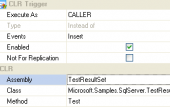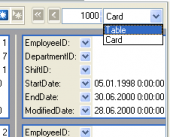MS SQL Maestro online Help
| Prev | Return to chapter overview | Next |
Editing CLR UDF properties
The Properties tab consists of two parts: Parameters and Properties.
The Parameters tab contains the list of the current CLR UDF parameters with its options. Here you can find the Name and the Type of each parameter of the CLR UDF and also the Comment for the parameter.
The Properties tab allows you to specify CLR UDF options according to your needs. The detailed description is given below.
Name
You can edit the CLR UDF name here.
Owner
Select the owner of the CLR UDF. By default, only the owner of an object can perform various operations with the object. In order to allow other users to operate it, privileges must be granted. (However, users that have the superuser attribute can always access any object.)
Comment
Specify a comment to the CLR UDF.
Create Date
Indicates the date when the CLR UDF was created.
Modify Date
Indicates the date when the CLR UDF was last modified.
Execute As
Specifies the security context under which the CLR UDF is to be executed.
Function Type
Defines Scalar, Inline Table-valued or Multi-statement Table-valued UDF function type.
Return Data Type
The field stands for the return data type of UDF. All data types, including CLR user-defined types, are allowed except text, ntext, image, and timestamp data types.
Parameters
Here you can find the list of the CLR UDF parameters.
Assembly, Class, Method
Specifies the method of a .NET Framework assembly for a CLR stored function to reference. Class must be a valid SQL Server identifier and must exist as a class in the Assembly.
See also: Assemblies
To apply the changes, select the Apply Changes item in the Navigation bar or use Ctrl+F9 or Ctrl+F7 shortcut keys.
It is also possible to modify object properties without opening the object editor: use the Object Properties item of the popup menu of the selected object from the explorer tree.
| Prev | Return to chapter overview | Next |





 Download
Download Buy
Buy
